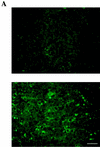The neural cell adhesion molecule is a receptor for rabies virus
- PMID: 9696812
- PMCID: PMC109940
- DOI: 10.1128/JVI.72.9.7181-7190.1998
The neural cell adhesion molecule is a receptor for rabies virus
Abstract
Previous reports strongly suggest that, in addition to the nicotinic acetylcholine receptor, rabies virus can use other, as-yet-unidentified receptors. We found that laboratory cell lines susceptible to rabies virus infection express the neural cell adhesion molecule (NCAM) (CD56) on their surface, whereas resistant cells do not, supporting the idea that NCAM could be a rabies virus receptor. We observed that (i) incubation with rabies virus decreases the surface expression of NCAM; (ii) treatment of susceptible cells with heparan sulfate, a ligand for NCAM, or with NCAM antibodies significantly reduces the rabies virus infection; and (iii) preincubation of rabies virus inoculum with soluble NCAM protein as a receptor decoy drastically neutralizes the capacity of rabies virus to infect susceptible cells. Moreover, we demonstrated that transfection of resistant L fibroblasts with the NCAM-encoding gene induces rabies virus susceptibility whereas absence of NCAM in the primary cortical cell cultures prepared from NCAM-deficient mice reduces the rabies virus infection and virus production. This provides evidence that NCAM is an in vitro receptor for the rabies virus. Moreover, the in vivo relevance for the use of NCAM as a receptor was demonstrated by the infection of NCAM-deficient mice, in which rabies mortality was delayed and brain invasion by rabies virus was drastically restricted. Our results showed that NCAM, which is expressed mainly in the adult nervous system, plays an important role in rabies infection. However, it cannot be excluded that receptors other than NCAM are utilized. Thus, the description of NCAM as a new rabies virus receptor would be another example of the use by viruses of more than one receptor to gain entry into the host.
Figures









Similar articles
-
Mutations conferring resistance to neutralization by a soluble form of the neurotrophin receptor (p75NTR) map outside of the known antigenic sites of the rabies virus glycoprotein.J Virol. 2002 Nov;76(21):10756-65. doi: 10.1128/jvi.76.21.10756-10765.2002. J Virol. 2002. PMID: 12368318 Free PMC article.
-
Role of GPI-anchored NCAM-120 in rabies virus infection.Microbes Infect. 2007 Feb;9(2):167-74. doi: 10.1016/j.micinf.2006.11.003. Epub 2006 Dec 5. Microbes Infect. 2007. PMID: 17208489
-
Rabies virus receptors.J Neurovirol. 2005 Feb;11(1):82-7. doi: 10.1080/13550280590900427. J Neurovirol. 2005. PMID: 15804965 Review.
-
Integrin β1 Promotes Peripheral Entry by Rabies Virus.J Virol. 2020 Jan 6;94(2):e01819-19. doi: 10.1128/JVI.01819-19. Print 2020 Jan 6. J Virol. 2020. PMID: 31666383 Free PMC article.
-
The acetylcholine receptor as a cellular receptor for rabies virus.Yale J Biol Med. 1983 Jul-Aug;56(4):315-22. Yale J Biol Med. 1983. PMID: 6367238 Free PMC article. Review.
Cited by
-
Subversion of the Immune Response by Rabies Virus.Viruses. 2016 Aug 19;8(8):231. doi: 10.3390/v8080231. Viruses. 2016. PMID: 27548204 Free PMC article. Review.
-
Rabies virus glycoprotein is an important determinant for the induction of innate immune responses and the pathogenic mechanisms.Vet Microbiol. 2013 Mar 23;162(2-4):601-613. doi: 10.1016/j.vetmic.2012.11.031. Epub 2012 Nov 29. Vet Microbiol. 2013. PMID: 23265241 Free PMC article.
-
Mutations conferring resistance to neutralization by a soluble form of the neurotrophin receptor (p75NTR) map outside of the known antigenic sites of the rabies virus glycoprotein.J Virol. 2002 Nov;76(21):10756-65. doi: 10.1128/jvi.76.21.10756-10765.2002. J Virol. 2002. PMID: 12368318 Free PMC article.
-
ACE2 and COVID-19 Susceptibility and Severity.Aging Dis. 2022 Apr 1;13(2):360-372. doi: 10.14336/AD.2021.0805. eCollection 2022 Apr. Aging Dis. 2022. PMID: 35371596 Free PMC article.
-
Proteomic analysis of membrane proteins of vero cells: exploration of potential proteins responsible for virus entry.DNA Cell Biol. 2014 Jan;33(1):20-8. doi: 10.1089/dna.2013.2193. Epub 2013 Nov 28. DNA Cell Biol. 2014. PMID: 24286161 Free PMC article.
References
-
- Alcaraz G, Goridis C. Biosynthesis and processing of polysialylated NCAM by AtT-20 cells. Eur J Cell Biol. 1991;55:165–173. - PubMed
-
- Beggs H E, Baragona S C, Hemperly J J, Maness P F. NCAM140 interacts with the focal adhesion kinase p125(fak) and the SRC-related tyrosine kinase p59(fyn) J Biol Chem. 1997;272:8310–8319. - PubMed
-
- Broughan J H, Wunner W H. Characterization of protein involvement in rabies virus binding to BHK-21 cells. Arch Virol. 1995;140:75–93. - PubMed
-
- Cole G J, Akeson R. Identification of a heparin binding domain of the neural cell adhesion molecule N-CAM using synthetic peptides. Neuron. 1989;2:1157–1165. - PubMed
Publication types
MeSH terms
Substances
LinkOut - more resources
Full Text Sources
Other Literature Sources
Medical
Molecular Biology Databases
Research Materials
Miscellaneous

